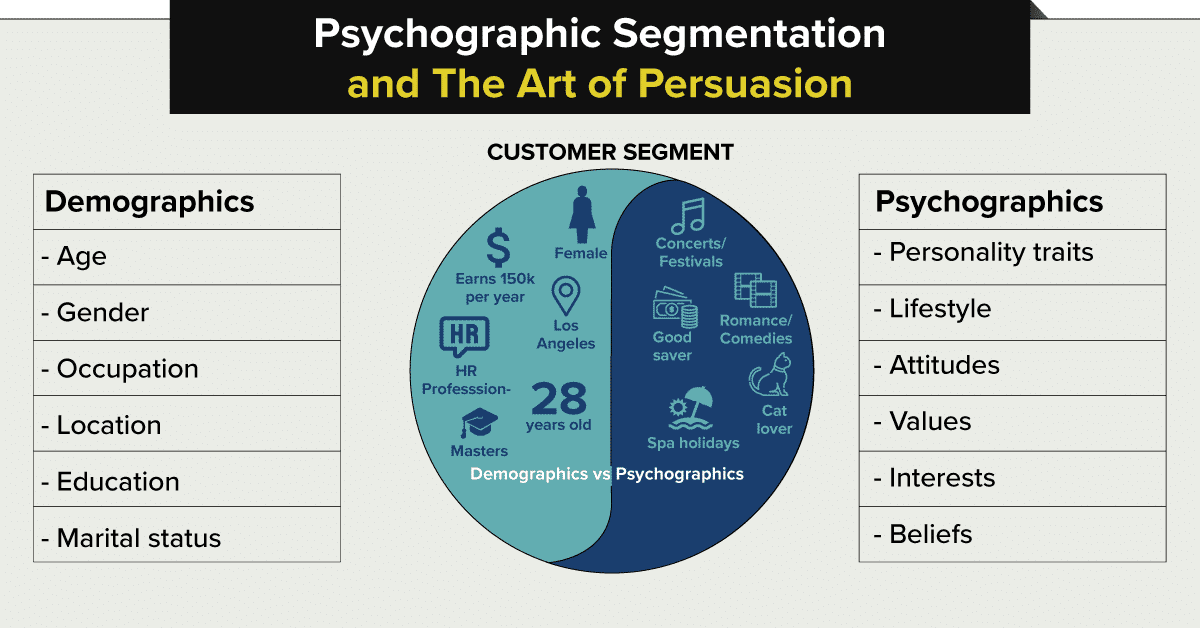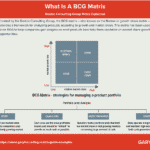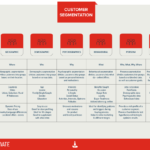Psychographic segmentation is the most powerful way you can target customers to generate leads and sales.
A marketing strategy focused on appealing to consumers’ personal emotions changes a nameless, faceless, perhaps soulless business into a brand that audiences relate to and care about.
In this article, I’ll take you through how to use psychographic segmentation in your marketing to achieve your goals.
What Is Psychographic Segmentation?
In a nutshell, psychographic segmentation is how marketers segment customers based on their interests, activities and lifestyle choices. They explain why people buy.
Psychographics is a qualitative approach to studying consumers based on psychological characteristics such as values, desires, goals, interests, and lifestyle choices.
In simple terms, demographic gives you an idea of who you are targeting, but psychographic is all about why people buy.
Personalization Delivers Results
The end goal of psychographic segmentation is:
- Improve the customer experience.
- Tailor products, services and offers to the right customer at the right time.
- Improve return on investment.
What are the benefits of Psychographic Segmentation?
The research shows overwhelmingly that using methods, like psychographic, to personalise marketing works:
- 80% of companies report seeing an uplift since implementing personalization. – Econsultancy
- Companies using advanced personalization report a $20 return for every $1 spent. – Clickz
- Marketers report that personalization efforts can boost revenues by up to 15%. – Adweek
- 86% of marketers have seen a measurable lift in business results from their personalization campaigns. – Evergage
- Millennial brand loyalty increases by 28% if they receive personalized communication. – SmarterHQ
- 95% of companies that saw 3x ROI from their personalization efforts increased profitability in the year after their personalization efforts. – Monetate
- 88% of U.S. marketers have seen measurable improvements due to personalization, with more than half reporting a lift greater than 10%. – Instapage
- Personalization can reduce customer acquisition costs by up to 50%. – Adweek
- Personalization can increase marketing spend efficiency by up to 30%. – Adweek
- Companies that exceed their revenue goals have a dedicated budget for personalization83% of the time. – Monetate
- 55% of marketers say the top benefit of personalization is increased visitor engagement and improved customer experience. – Evergage
The key to success though is understanding the psychology and behaviour of your customers.
Nearly every decision we make involves emotions, including subconscious ones.
Understanding what triggers those emotions can go a long way when it comes to developing effective marketing.
Psychographics allows you to hook into the deeper motivations and emotions that influence potential customers.
How Emotional Triggers Link to Psychographics
Emotional branding works well across all marketing. Successfully using emotions in branding and marketing requires a coherent approach to how you research and understand customers.
Going beyond the “I know my customers” to really doing the research makes an enormous difference to results.
In other words, it is worth the upfront investment in time and money to do it.
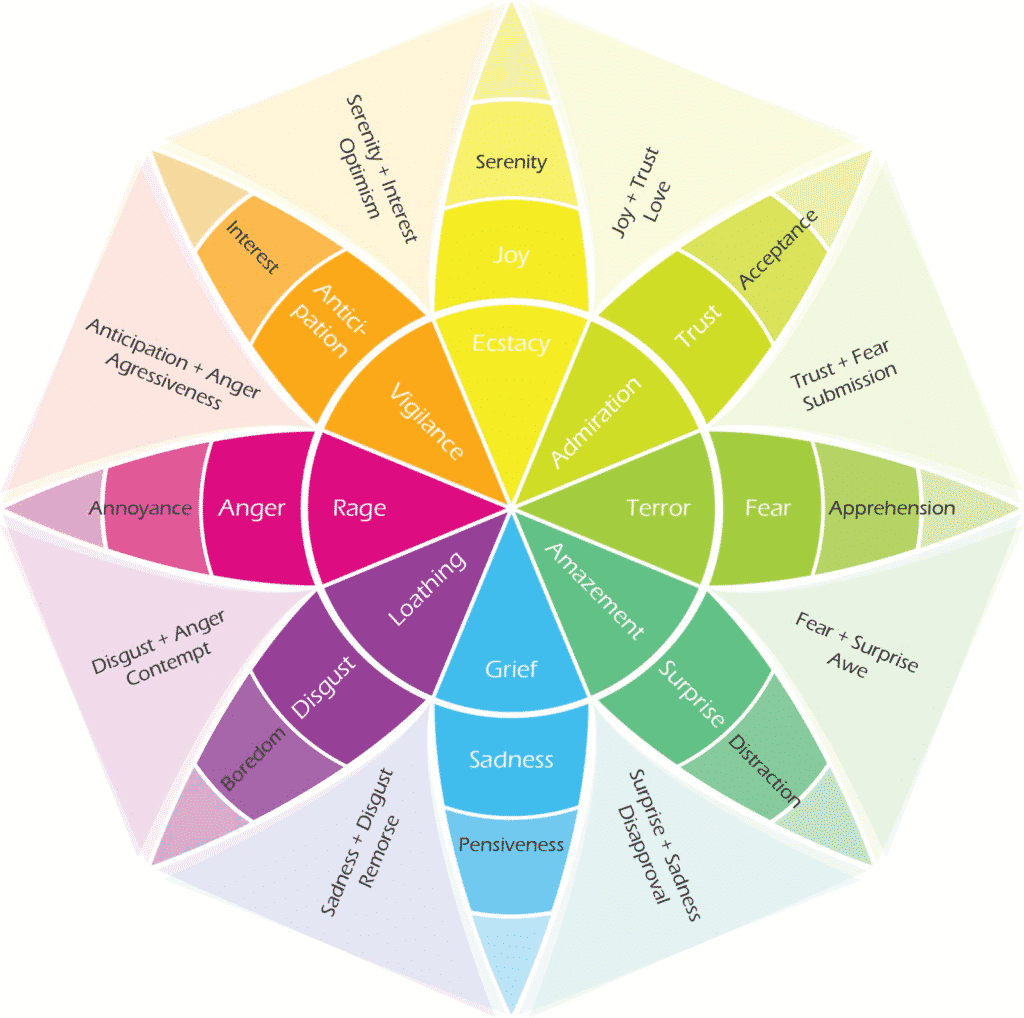
Every decision we make involves emotions, usually subconscious influencing our choices. Understanding those emotional triggers proves the foundations for developing effective marketing.
By understanding those triggers are how to use them, you can achieve more and get better results from your marketing.
Here are just two examples:
1. Belonging
Belonging helps to validate who we are and forms the basis for groups, a clan, a family or social network. We are naturally attracted to like-minded people. People often buy to feel associated with a group and demonstrate their identity to it.
Example of how it is used in advertising. Apple plays on the differences between Mac users and Microsoft, but it also crafts a sense of people belonging, which of the two would you want to be associated with!
2. Aspirational
Customers often have a picture of their future, a better version of themselves, more money, a better career…
By understanding customers motivations you can harness this in your marketing.
Example: Social status is a key driver for luxury goods. Often people buy luxury goods because they aspire to a higher social status. This is further reinforced by often by influencer marketing, where brands are linked to popular people on social media. People who drive a Tesla do so because they believe in the company’s aspirational mission: “to accelerate the world’s transition to sustainable energy.”
3. Values, Beliefs and Emotions

Values are emotional states that, based on our life experience, we believe are most important for us to experience (move toward) or avoid (move away from).
The moving-toward values, or “pleasure” values, are emotions like love, happiness, success, security, adventure.
Some people may say that what they value most in life are their cars.
Well, it’s true they may value a car (i.e., it’s important to them), but they value it as a means, a way to get what they’re really after. The end a person who values a car might be seeking is a sense of convenience or a sense of freedom or, depending upon the type of car, maybe a sense of power or fun.
A belief is a feeling of certainty about the meaning of something. Your beliefs determine whether or not you feel like you’re meeting your values—they can either limit or liberate you.
There are two basic kinds of beliefs:
- Global beliefs are generalizations: – “Life is…,” “People are…,” “I am…”
- Rules are conditional ideas: – “If this, then that.”
| Move Towards | Move Away from |
|---|---|
| 1. Health | 1. Depression |
| 2. Success | 2. Boredom |
| 3. Happiness | 3. Overwhelm |
| 4. Growth | 4. Anger |
| 5. Love | 5. Worry |
| 6. Contribution | 6. Frustration |
| 7. Humour | 7. Resentment |
| 8. Intelligence | 8. Sadness |
| 9. Power | 9. Jealousy |
| 10. Affection | 10. Self-pity |
In marketing communications, you can connect potential customers to your brand by linking to their motivations and beliefs. Are you helping move them towards or away from an emotional state.
Why You Need to Segment Your Customers
Every marketer uses different market segmentation techniques in their marketing.
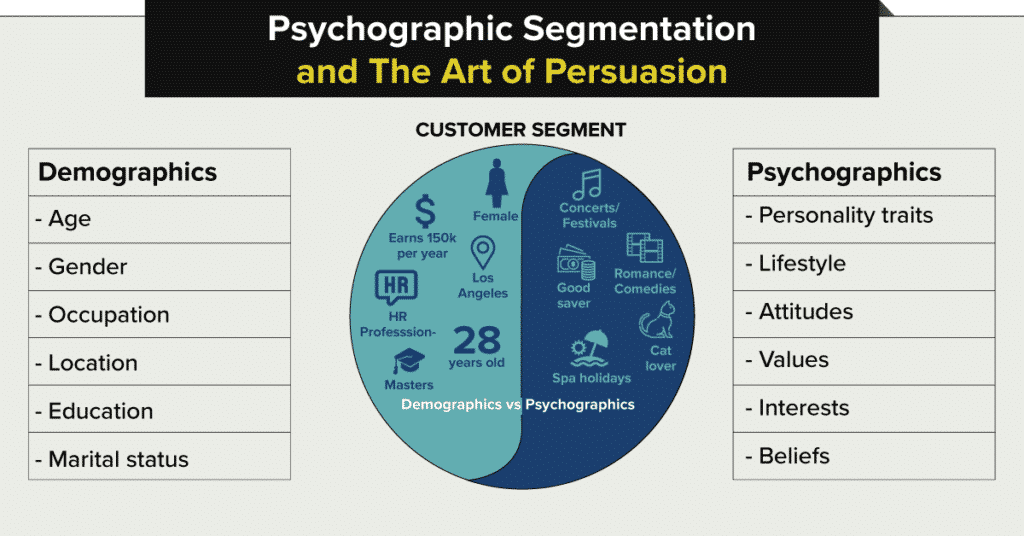
Psychographic Definition and Guide
And the golden rule of marketing is all to match your product or service to your customer’s needs.
That’s great, but to implement that you need to know how and why different customers use your product or service.
Then when you communicate with the different customers you can talk to them and make a real connection.
As an example, a businessman might book a restaurant for different purposes. In one instance he may book a table to take his boss out for a meal. In another instance, he may take his partner there for a romantic meal.
Knowing how and why customers use your product or service matters.
This is also true when you spend money on advertising.
The golden rule of advertising, for Facebook or Google ads, is that you want to get the lowest ad cost and highest number of clicks.
If you target too broad an audience you will burn through money quickly end up with little or no leads.
Even if you nail it with by optimising some experiments, you won’t be using your ad spend efficiently.
That’s why segmenting your audience is so important.
You make your marketing more relevant to your audience.
That rule also applies to email marketing and all other aspects of your marketing.
What’s the Difference Between Psychographics vs Demographics?
Demographics is facts about a persons age, income, education and location. Psychographics is concerned with what they like to do, find interesting and what motivates them.
Most marketers will combine both demographic and psychographic data for a 360 view of a consumer. In doing so, they can provide more tailored messaging and increase their chances of impact.
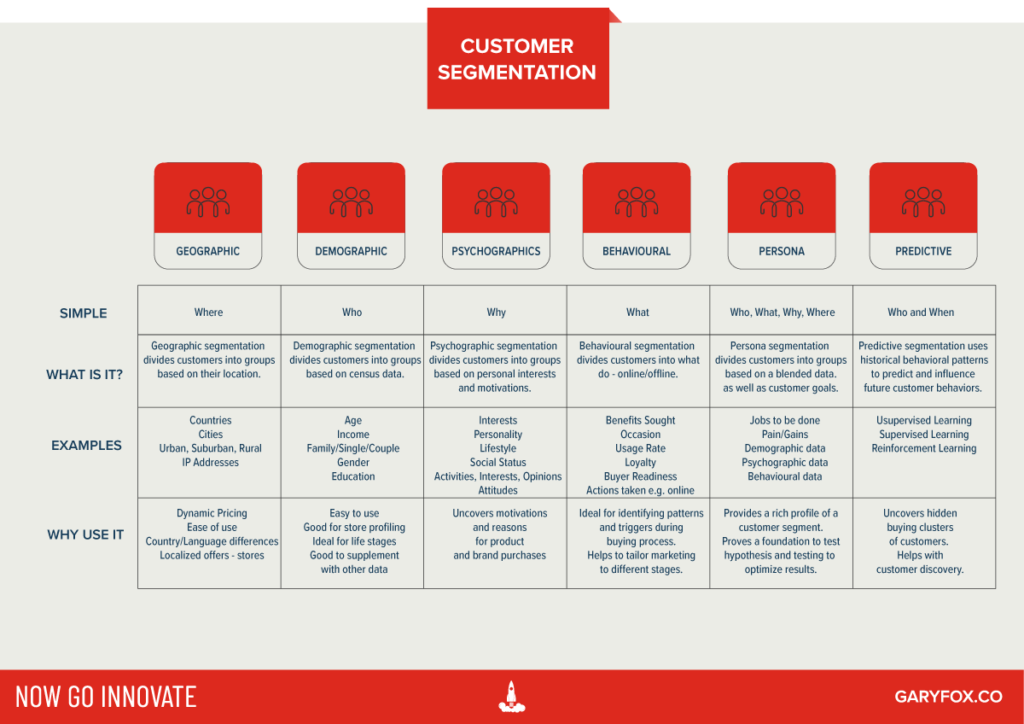
Let’s compare demographic and psychographic segmentation side by side.
| Demographics | Psychographics |
|---|---|
| – Age | – Personality traits |
| – Gender | – Lifestyle |
| – Occupation | – Attitudes |
| – Location | – Interests |
| – Education | – Activities |
| – Religion | – Values |
| – Martial Status | – Ambitions/Goals |
As you can see the demographic data helps you profile a customer segment but it doesn’t lock in what motivates them and how your product fits into their life or solves a problem.
The Advantages of Psychometric segmentation
- Understand customer needs and motivations by analyzing their personalities, lifestyles and/or social status.
- It improves communications and enables you to talk at a personal and emotional level with customers.
- Your communications will appeal to how you can improve their lives and not just on the features and benefits of your product or service.
- It provides more insights into how your customers use your product – it helps with the jobs to be done framework.
How To Really Understand Your Customers
Let’s imagine you’ve got a new business and have already done some research on potential customers.
One of the first things you want to do is to create a customer persona – a profile of your ideal customer segment.
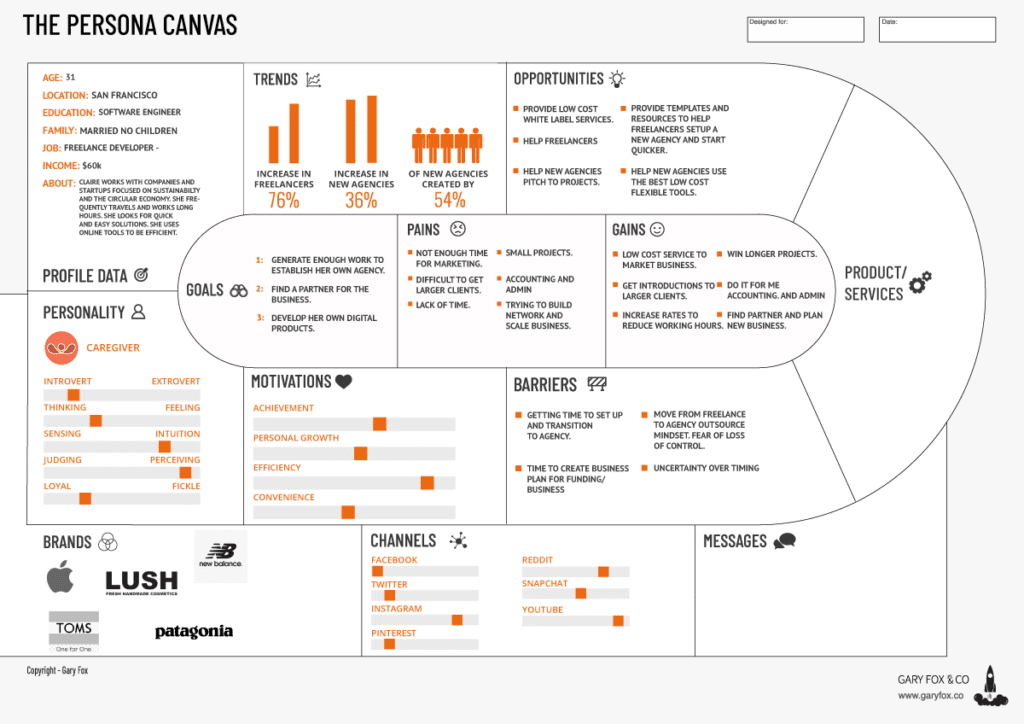
To create a complete profile you want to understand your customers.
Examples of Psychometric Variables
1. Personality
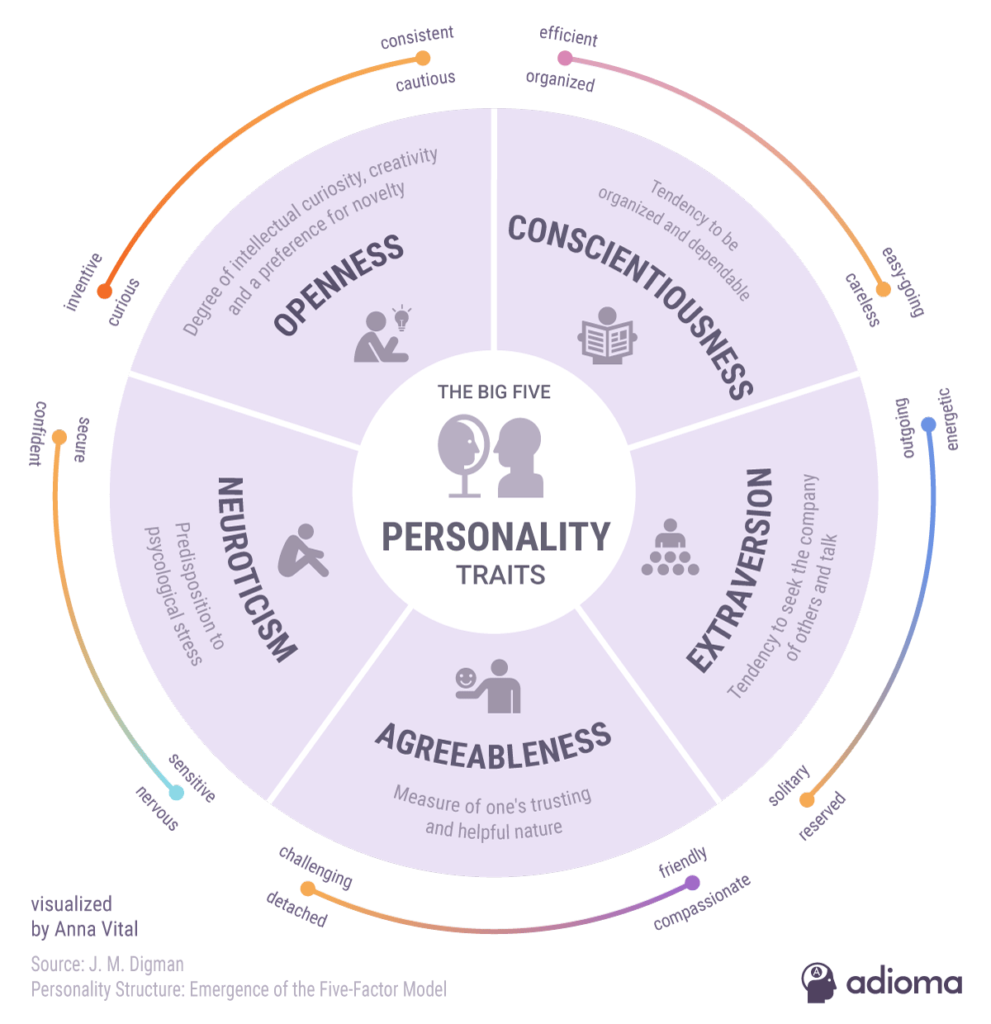
Personality describes the collection of traits that someone consistently exhibits over time.
Example: one personality trait that is part of the 5-Factor Model is extroversion. You can see in the personal profile that this is a range, not an absolute. So always be careful to moderate how you profile your customers.
As an example, if you sell software to developers online you might have discovered the average developer scores low in extroversion. In other words, they are more likely to be introverts than extroverts.
2. Lifestyle
Lifestyle is simply the day-to-day activities that people choose to do. The easy way to think about it is how and what people do with their time. You can segment customers based on:
- activities a person enjoys (and will spend money on).
- how much they enjoy and engage in those activities.
- how they make purchases on those activities.
Example: if you want to promote your a health supplement to an audience, you might look to target people that are into fitness. Depending on your supplement you might choose to target gym junkies – those that go 5 times a week or more.
3. Interests
Interests can be active or more passive. Active interests can overlap with lifestyles, e.g. people who are interested in yoga and go to yoga classes. Passive interests can be reading a certain genre of books or have an interest in sailing. One client helped people to buy sailing yachts. Quite incredibly, over 40% of their database love finding out about yachts, locations, experiences but could never afford a yacht.
Another example: an online fashion website may discover that a substantial proportion of its users also enjoy certain music artists. This might prompt the company to use famous music celebrities in their ad campaigns.
4. Opinions, attitudes and Beliefs
What you belief is often reflected in your opinions and attitudes. Politics is the a powerful example of how psychographic data can be used to sway voters.
Cambridge Analytica famously used big data and AI to analyse profiles of voters and then target them with messages to sway their voting behaviour. The messages played specifically on their beliefs and attitudes.
5. Social Status
Brands like Rolex have a good idea of who their target audience is: they aim their products at the upper-class consumer with high quality and high prices. Many other luxury brands playfully use social status to appeal to not just the wealthy but often the middle class who aspire to wealthy.
But how do you collect data about your customers without hitting privacy issues?
How To Collect Psychographic Data
There are several different ways to gather and analyze psychographic data. Some methods include the use of:
- Traditional focus groups/interviews
- Set-top box viewing data
- Surveys/questionnaires/quizzes
- Psycholinguistic dictionaries
- Website analytics (e.g. Google analytics)
- Browsing Data
- Social media (i.e. likes, clicks, tweets, posts, etc.)
- Third-party analytics
1. Google Analytics
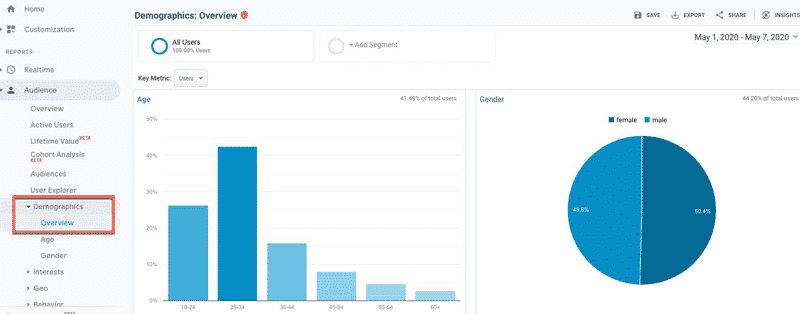
You can also gain customer insights from the Interests section.
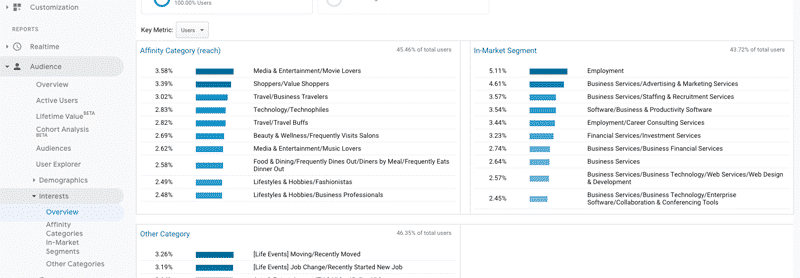
2. Facebook
Facebook’s Audience Insights is often overlooked by marketers. Yet it is one of the most powerful tools to understand your audience. You can find out what their interests are, and how they behave across Facebook’s your page and more.
Audience Insights is part of the Ads Manager section of Facebook. It gives you insights from your Page admin and shows psychographic data about your audience, such as common job titles, relationship status, education level, income and home value, device usage, retail and online spending behaviour, top interests (both categories and specific pages), and activity on Facebook.
3. Text Analytics, Big Data and AI
Social media generates huge amounts of data. Recently, there have been big advances in the analysis of this data by sifting through and then categorizing it. Out of this data comes the ability to infer human characteristics via language and behavioural analyses, generating profiles that can be used to predict consumer responses.
People explicitly declare a portion of their interests in topics like sports, music, and politics in their bios and posts. A person’s social activity can also reveal many other aspects, including demographics (e.g. gender, age, racial identity, location, and income) and psychographics (e.g. personality and status).
Since 2012, IBM has been compiling Linguistic Inquiry and Word Count (LIWC), a psycholinguistic dictionary that uses Twitter as its dataset.
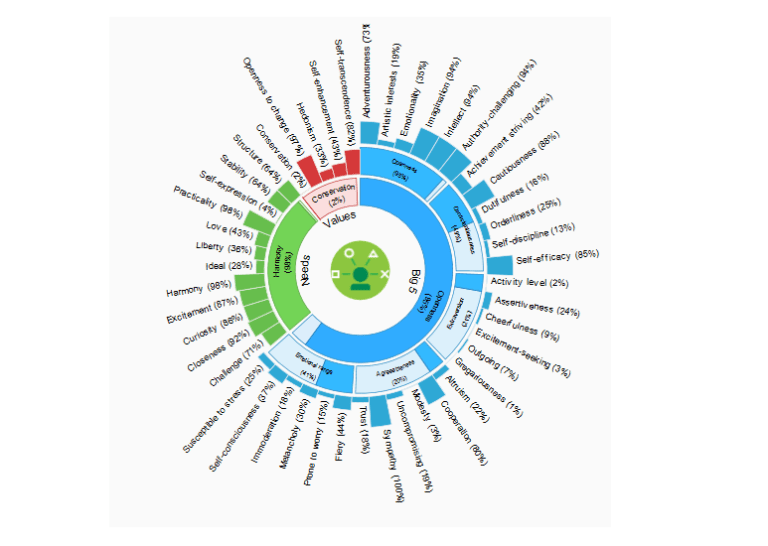
Using this dataset to train its AI engine, Watson, IBM has a refined set of “algorithms” that sort and retrieve psychographic information from emails, blog posts, text messages, search histories, online purchases, online reviews and comments, and, of course, social likes and shares.
Businesses can harness these insights to drive more targeted marketing campaigns, acquire new customers, personalize consumer connections, and more.
Text-based datasets like these are particularly useful: “psycholexical studies” have shown that personality traits often show up in people’s word choices. To use one of Nix’s examples, because words like “apparently” and “actually” are indicative of a high degree of neuroticism, people whose harvested data frequently featured words like this would be marked as high “N” in their psychographic profile. Other linguistic markers could be mapped to the other Big 5 personality traits (OCEAN).
4. Quizzes
Quizzes are underrated by many marketers. They not only create lots of traffic, but also are great for improving your sign-ups because they appeal to people’s curiosity.
They work because they are engaging and interactive. With quizzes, you can ask both open and close-ended questions without it feeling like a survey and dig deeper into your customers psychographics.
5. Focus Groups and Interviews
Interviews can be conducted in person or over the phone. Over the phone interviews are cost less and are more likely to generate honest feedback because they are in customers are in their own environment.
Focus groups are a good way to involve a wide range of customers and offer more time to investigate their thoughts, feelings and motivations. However, it is important to be aware of the “group effect,” where participants’ answers are biased by outspoken people in the group.
Tips On Using Psychographic Segmentation
You might get lots of data and useful insights. However, you have limited time, budget and targets to hit. try to align your insights with your goals. Here’s what you to focus on:
- Optimize your customer experience: pick out the top pain points or opportunities to exceeded customers expectations.
- Optimize the website: less is more and refine your messages to sharpen your value proposition.
- Update your product roadmap to address buying needs: remember that product usage and product buying criteria are different.
- Refine your ads: make sure your ads ( and other marketing communications) harness the power of those psychological levers that make people buy. Use what works and discard what doesn’t.
Ready to try it yourself?
Create your own fleshed-out customer persona can take your messaging and your sales to the next level. Download a persona canvas today.
